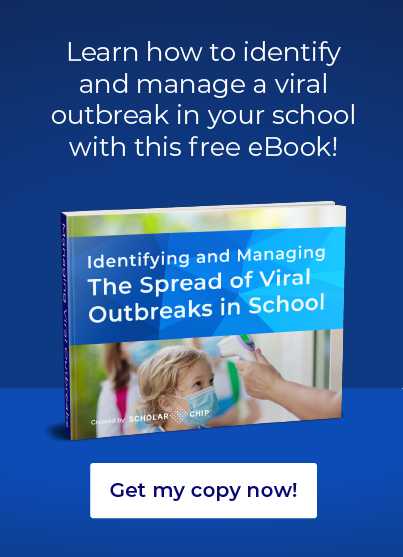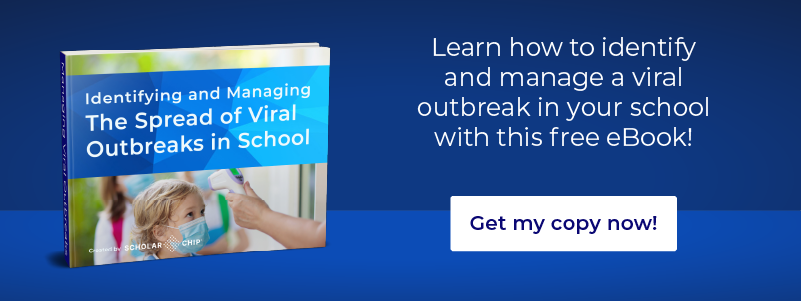The Centers for Disease Control and Prevention (CDC) has told school districts to prioritize opening their campuses for the school year. But risks exist in reopening even the most cautious schools. One of administrators’ significant worries is handling contagious illnesses like COVID-19. The scenario of a student coming to school sick—exhibiting symptoms or not—is a contingency that administrators must prepare for.
Create school cohorts to limit the impact of a sick student.
One of the CDC’s recommendations for limiting the spread of illness in schools is creating cohort models. This is a small group of students who come into contact only with each other and no other students. Often, they don’t move from class to class but instead, have teachers go to them.
If you choose cohort learning for your school, then a sick student will only have the possibility of infecting a smaller group of students, instead of the entire campus community.
Of course, it can seem daunting to establish cohorts at your school, but ScholarChip can help. Each student can be assigned a One Card, a tool that gives each student a unique identifier. Then, install Secure Door Access readers outside of every classroom door. After students have been divided into cohorts, their One Cards will prevent them from accessing classrooms other than their assigned ones.They won’t be able to come in contact with children in other classrooms.
Quarantine sick students until they can be picked up.
If a student starts exhibiting even mild symptoms at school, it’s important to quarantine them away from the rest of the population, even before they’ve been tested. COVID-19 doesn’t follow standard processes for handling contagious illnesses. While in the past, a child with a mild cough might be left to finish out the rest of the school day, it’s essential to take even mild symptoms seriously.
So, be sure you have a space where a sick student can stay separate from their peers. Keep them isolated until their parents or caregiver can pick them up.
This is another scenario in which ScholarChip tools can be useful. You only want a child’s caregiver to be able to pick up the child and that no other visitors can access this quarantine room. For every person visiting the campus, make sure to log them into the Visitor Management system. This tool keeps track of when a visitor comes onto campus and when they leave. That way, you can make sure sick children have been picked up from school and don’t have further contact with other students or staff.
Be sure to ask parents to test their sick children for COVID-19 and report positive diagnoses to the school.
Require that parents keep their sick child at home for fourteen days after a COVID-19 diagnosis.
COVID-19 is contagious for up to fourteen days after the first signs of illnesses. Even if students are “feeling better,” that doesn’t mean they’re actually well. Even asymptomatic children can be contagious to others. Therefore, students shouldn’t return to campus for two weeks and until they’ve tested negative for the virus.
Close your campus after a confirmed illness.
If you have taken precautions for limiting the spread of the illness, then the CDC recommends that you close schools for two to five days after a confirmed case. Dismiss most staff and faculty from campus as well. This closure is intended to give your cleaning crew the time to thoroughly clean and disinfect every classroom or common space that the sick child entered. If you can track the ill child’s movement using their One Card, this process will be easier.
In some cases, you may have to close your campus for longer than five days. If you haven’t implemented a cohort model, the sick student may have come in contact with many other students, faculty, and staff. If that’s the case, you may want to close your campus during the entire possible incubation period for COVID-19, which is two weeks.
Call the parents and guardians of children in the sick person’s cohort.
If you only close your school for a limited period, it’s still important to talk to the other students and faculty with whom the sick child has had contact. If you use a cohort model, contact the parents of the other members of the cohort to let them know that their children may have been exposed to COVID-19. The cohort group should have options for virtually learning from home for fourteen days, ensuring that should they be infected, they won’t spread the disease any further.
When it comes to reopening schools, it’s crucial to take social-distancing precautions and have specific plans for handling a contagious illness. In preparing for an ill student on campus, consider how to limit the viral spread. This way, if a sick student does come to your school, you’ll be prepared to lessen the impact of their illness.
The ScholarChip team is dedicated to helping school leaders maximize the safety and well-being of students and the entire school community.
Not sure what you should do to be able to identify and manage the spread of a viral outbreak in your school or school district? Feel free to chat with one of our school crisis communication specialists today!


